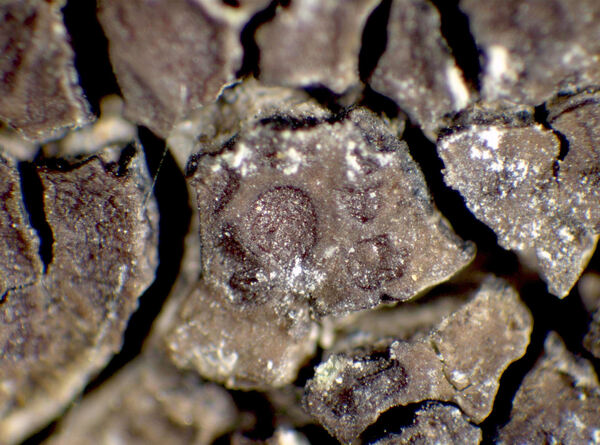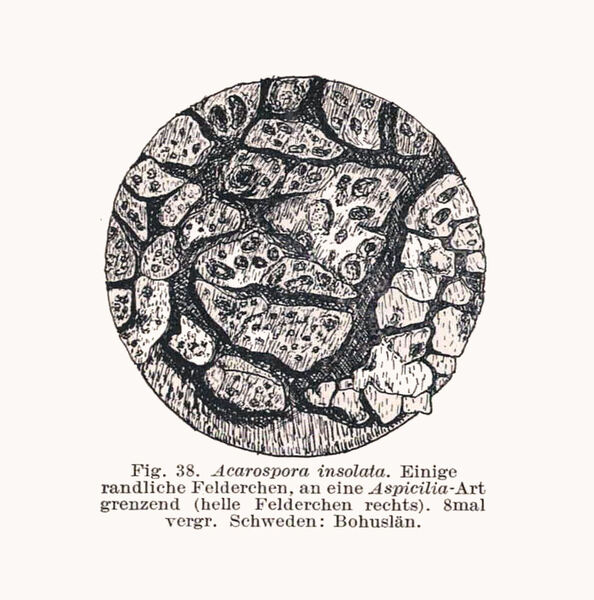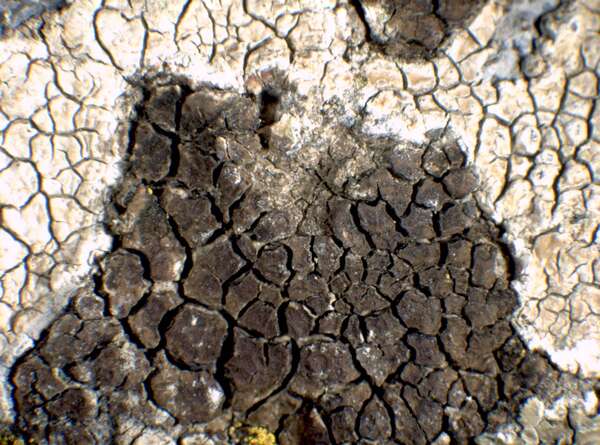Acarospora insolata H. Magn.
Göteb. Vetensk.-och Vitter.-Handl., ser. 4, 28, 2: 112, 1924.
Synonyms:
Distribution: N - Ven, Piem (LD -1549228), Emil (Fariselli & al. 2020). C - Tosc, Sar (Rizzi & al. 2011). S - Bas (Nimis & Tretiach 1999).
Description: Thallus crustose-subsquamulose, episubstratic areolate, medium brown, shiny, forming small patches, usually developing on the thalli of other crustose lichens. Areoles angular or rounded, slightly convex, 0.4-1.5(-3) x 0.3-2.4 mm, finely subdivided into smaller units by a dense network of fissures, dispersed or aggregated into small groups amongst the areoles of the host; lower surface black, visible along the margins. Cortex 20-30(-50) μm thick, overlain with a to 15 μm thick amorphous layer, the cortical cells 2-3 μm wide; algal layer continuous; medulla white, without crystals. Apothecia 0.2-0.4 mm across, immersed in the areoles, (2-)5-12 per areole, often confluent and poorly developed, round to elongate, with an initially concave, then flat, reddish brown disc, and a more or less prominent, sometimes indistinct thalline margin. Proper exciple thin, poorly developed; epithecium brown; hymenium colourless, 50-60(-80) μm high, euamyloid, IKI+ persistently blue; paraphyses stout, 2-2.5 μm thick at base, the apical cells to c. 3 μm wide; subhymenium and hypothecium colourless. Asci c. 100-spored, clavate, the apical dome K/I-. Ascospores 1-celled, hyaline, broadly ellipsoid, 3-5 x 2-3.5 μm. Photobiont chlorococcoid. Spot tests: cortex and medulla K-, C-, KC-, P-, UV-. Chemistry: without lichen substances. Note: on inclined faces of siliceous rocks wetted by rain, usually parasitic on crustose lichens, especially Rhizocarpon and Immersaria. Probably more widespread in the mountains, especially in the Alps. The species does not belong to Acarospora s.str. (Westberg & al. 2015).
Growth form: Crustose
Substrata: rocks
Photobiont: green algae other than Trentepohlia
Reproductive strategy: mainly sexual
Subcontinental: restricted to areas with a dry-subcontinental climate (e.g. dry Alpine valleys, parts of Mediterranean Italy)
paras Immersaria and Rhizocarpon spp.
Commonnes-rarity: (info)
Alpine belt: rather rare
Subalpine belt: rare
Oromediterranean belt: very rare
Montane belt: very rare
Submediterranean belt: extremely rare
Padanian area: absent
Humid submediterranean belt: extremely rare
Humid mediterranean belt: extremely rare
Dry mediterranean belt: absent

Predictive model
Herbarium samples
Growth form: Crustose
Substrata: rocks
Photobiont: green algae other than Trentepohlia
Reproductive strategy: mainly sexual
Subcontinental: restricted to areas with a dry-subcontinental climate (e.g. dry Alpine valleys, parts of Mediterranean Italy)
paras Immersaria and Rhizocarpon spp.
Commonnes-rarity: (info)
Alpine belt: rather rare
Subalpine belt: rare
Oromediterranean belt: very rare
Montane belt: very rare
Submediterranean belt: extremely rare
Padanian area: absent
Humid submediterranean belt: extremely rare
Humid mediterranean belt: extremely rare
Dry mediterranean belt: absent

Predictive model
| Herbarium samples |
 Index Fungorum
Index Fungorum
 GBIF
GBIF





